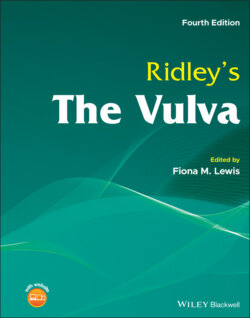Читать книгу Ridley's The Vulva - Группа авторов - Страница 28
End of the female embryonic period and further development (week 8 onwards)
ОглавлениеAt the end of the embryonic period, the foetus has gonads that are recognisable as ovaries, but still has indifferent external genitalia, and both mesonephric and paramesonephric duct systems are still present. Subsequent sexual differentiation of these ducts in the female develops because of a lack of anti‐Müllerian hormone. The mesonephric ducts (Wolffian ducts) degenerate, but occasionally remnants may be left behind. A remnant of the cephalic mesonephric duct and adjacent vesicles is a constant finding associated with the ovary. A more caudal portion of the mesonephros may be encountered in the broad ligament as the paroophoron, while remnants of the terminal mesonephric duct may persist lateral to the uterus and vagina or be incorporated into the cervix. Remnants of this duct found adjacent to the lower genital tract are referred to as Gartner’s ducts.
The fallopian tubes, uterus, and cervix develop from the upper un‐fused portions of the paramesonephric ducts and the vagina from the lower fused portion (Figure 1.11a). The arrival of the caudal end of the genital canal on the urogenital sinus stimulates cellular proliferation of the sinus epithelium to form three projections (sinuvaginal bulbs) which displace the genital canal dorsally (Figure 1.11b). Failure of these bulbs to develop results in vaginal agenesis. These sinuvaginal bulbs become solid and together with the solid end of the genital canal form the vaginal plate, which is complete at 19 weeks (Figure 1.11c). The sinuvaginal bulbs later fuse, but eventually undergo apoptosis to form a lumen. Sometime between 14 weeks and 20 weeks, the vagina opens into the pelvic portion of the urogenital sinus, forming the vaginal vestibule (Figure 1.11d)
Figure 1.11 (a) The fused paramesonephric ducts form the genital canal, the solid caudal end of which abuts on the posterior wall of the urogenital sinus at the sinus tubercle. (b) Cellular proliferation of the sinus epithelium generates the sinuvaginal bulbs, which displace the genital canal dorsally. (c) Further cellular proliferation converts the sinuvaginal bulbs into solid tissue projections, which participate in the formation of the vaginal plate. (d) Extensive caudal growth of the vaginal plate brings its lower surface into the primitive vestibule.
Further feminisation of the external genitalia begins between 63 and 77 days, when the genital tubercle lengthens to form the phallus. This then bends caudally to form the glans of the clitoris. During this period, the anogenital distance remains unchanged, there is no fusion of the genital folds, and the urogenital sinus remains open. The urethral and vaginal openings separate later. The phallus becomes the clitoris, being incorporated within the fused anterior ends of the genital folds, which develop into the labia minora. The genital swellings lateral to the labia minora become the labia majora and are continuous with the future mons pubis. The labia minora develop from the genital folds and divide anteriorly into the prepuce and frenulum of the clitoris (Figure 1.12).
Figure 1.12 (a) The genital and anal membranes rupture. (b) In the female foetus, the urogenital sinus remains open as caudal growth of the vaginal plate brings the urethral and vaginal openings into this region, converting it into the vestibule.
